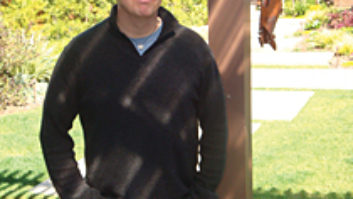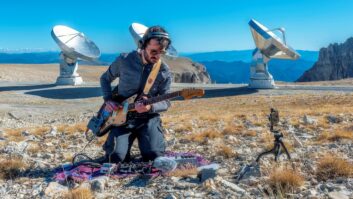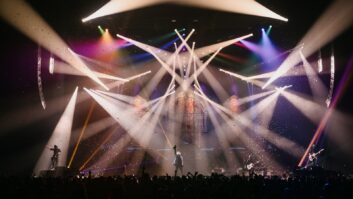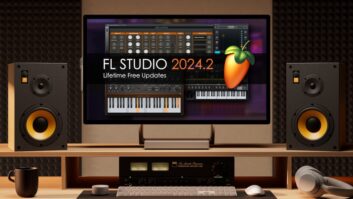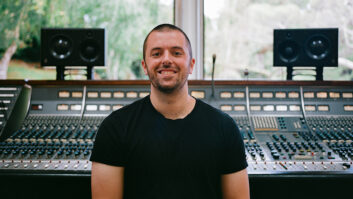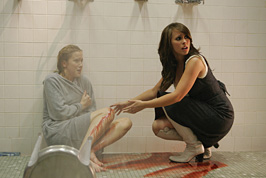
Who knows what a ghost sounds like? The old clichés of moans, rattling chains and wind don’t quite hold up in 2007 — especially when sound effects creators have to deal with new sounds for a weekly TV series, as on CBS’ hit show Ghost Whisperer.
Jennifer Love Hewitt (right) plays Melinda Gordon, who communicates with spirits in Ghost Whisperer.
“That’s the challenging thing about this show,” says supervising sound editor Mark Friedgen of Burbank, Calif.-based Smart Post Sound. “We sort of have a ‘ghost of the week,’ so each week we have to ask ourselves, ‘What is this show’s ghost going to sound like?’ They all need to be different.” Roberta Doheny, who, along with Bob Edmondson, mixes the show, agrees: “Every show has a different ghost character, and that has to be reflected in the mix, too.”
As with most series, the process begins with creating a temp track by the show’s picture and music editors (referred to as the “Avid mix”). This includes effects Smart Post Sound has sent and any from libraries the picture editor has available. Music editor Gordon Fordyce also adds a fairly elaborate temp music track — including music from previous episodes and even non-show-related music — to substitute for composer Mark Snow’s forthcoming score.
Even at this early stage, Smart Post is sometimes called on to create a ghost sound, particularly for a more challenging spook. “I’ll get a call from the editor even while he’s in his very first rough cut,” Friedgen notes, “and he’ll say, ‘You know, Mark, I need a sound for this ghost. Maybe you can come up with some ideas.’” In as little as a half-hour, after receiving a QuickTime clip from the editorial team, a sound will be developed, which can be uploaded to Smart Post’s server for quick incorporation into the temp track.

From left: sound mixers Roberta Doheny and Robert Edmondson, and sound editor Mark Friedgen
SPOTTING FEAR
On the Monday or Tuesday the week before the mix, a spotting session is held in the editorial office, typically attended by executive producers Ian Sander and Kim Moses, co-producer Juanita Diana Feeney, the picture editor, Friedgen and ADR editor/co-supervisor Tim Terusa. In addition, composer Snow may participate via telephone from his studio in the New England area.
Sander and Moses will elaborate on the episode’s tone and, most importantly for the sound team, about the nature of the ghost. “In one show, for instance, the general feeling about the ghost was cold,” Friedgen explains. “So we’ll have a lot of icy, rattly kinds of sounds,” some of which Snow will provide in his score. “We’ll look for those opportunities and discuss them, some of which the producers will like and some they won’t. It’s a give-and-take process. We’re deciding what a ghost sounds like. You kind of have to sell it.” The sound is often dependent on how the ghost character died, Edmondson notes. “It depends on whether they were in shock, hit by lightning, et cetera.”
The series also contains some visual effects shots, which are often fairly complex. “They come up with lots of interesting visuals on this show and those need sound to help support the images they’re trying to get across in their storytelling,” Friedgen explains.
After the spotting session, Friedgen and Terusa return to Smart Post, where Terusa will begin assembling a master ADR list to cue each line. Friedgen’s notes from the session are transcribed, and he will run through the reels with his dialog and effects editing teams. After the production dailies are loaded and assembled at Smart Post, the two dialog editors, Anton Holden and Joy Ealy, prepare those tracks for dubbing.
Effects editors Bob Costanza and Mike Dickeson then dig into creating the sounds for the episode. “With our tight schedules, we split the show up, with Bob cutting the first two acts and Mike cutting the last three, which is roughly half and half for each,” says Friedgen.
The ghost sound effects are created mostly from what, at this point, is a fairly extensive library of sounds, manipulated in any number of ways. “With Pro Tools, there are so many different ways to manipulate sound,” Friedgen continues. “We can take pre-existing sounds, perhaps a combination of several, and slightly pitch them up or down,” and process them in a variety of manners to produce a unique ghost identity.
Though the tight schedule necessitates using a library, typically one or two sounds per show require field-recording a new source. Sometimes, these can include the proverbial “kitchen sink” — or something close to it. “A couple of weeks ago,” Friedgen remembers, “we had a ghost that was like a spinning vortex. I had a sink in my garage that made this great sound when it would drain, so I recorded it. We brought that back to the studio and pitched it a bit and worked with it and added some wind sounds. And we ended up with this pretty cool spinning vortex sound.”
Ghost Whisperer spirits do have some signature sounds that audiences get to know, most of which are spelled out in a “Rules for Ghosts” bible back at the production office. One such spec requires a low “boom” to be heard each time a ghost appears or leaves; other sounds are produced whenever a ghost moves within a scene. At the end of each episode, when the ghost has resolved its differences and heads off to the heavens (or “crosses over”), “We have this little sound like a portal opening, where there’s a gentle wind, which is always the same sound,” Friedgen explains.
Occasionally, cast members’ own voices form the basis of the ghost’s sound. Some, if scripted, will be recorded wild on the set by the production mixer, while others will be recorded on the ADR stage. In either case, they will likely be augmented in post. For instance, in one episode this season, a little girl had drowned in the family pool but continued to haunt the home and its new owners. “The little girl had this really small, squeaky little voice, and they wanted her to sound evil,” Friedgen explains. “There was nothing we could do to make it sound right: plug-ins, processors — it just never sounded mean enough.” The young actress came to the ADR stage and re-voiced her performance, sounding as “mean” as she could. In addition, both male and female actors performed the same lines in group ADR.
All of the tracks are processed at Smart Post, and then at the mix, different combinations of those recorded voices are used to achieve the sounds the producers are after. “I think it has six different sources,” he says.
A GHOSTLY MIX
By Sunday night, Smart Post’s sound files are loaded onto FireWire drives and brought to Dub Stage 1 at Universal’s Henry Mancini Building, where the mix takes place over the next two-and-a-half to three days. “I can’t begin to say enough about how wonderful it is working here at Universal,” says Doheny. “We have some of the best engineers in the world here. They’re constantly keeping the equipment updated. It’s a fabulous environment.”
The team doesn’t actually walk in cold on the week’s episode. “They always bring us a DVD of the show that we’re going to be working on the following week, which we have a chance to watch at our leisure,” Doheny explains. “We listen to the editor’s mix track and get a feel for where they’re going so that when we come in Monday morning, we know the story.” While the team may begin to have a grasp of the show’s approach from viewing the edit, it is the arrival of Snow’s score that sets the final tone.
All of the source reel material is loaded into the system, including the temp track, sound effects, dialog, ADR, Foley and Snow’s music stems. “We actually cut the temp tracks right into my session and then we cut around them,” Doheney explains. “We integrate what we think is really good, and a lot of it is.” The Avid mix is also kept on hand to compare against the final mix to make certain the editor’s original intent is kept intact.
Joining Doheny and Edmondson are Friedgen and/or Terusa, recordist Richard Coleman, music editors Gordon Fordyce and/or Grant Conway, and co-producer Juanita Diana Feeney. “Juanita runs the mix,” says Friedgen. “We follow her guidance very, very closely, so that when the executive producers come for playback, we’re as close as possible to what they expect.”
Having worked together for five years on such series as Law & Order: Criminal Intent, LAX, Providence and others, Doheny and Edmondson have a work process established that allows them to proceed smoothly through an episode. Generally, they split the work — Doheny focusing on dialog and music, Edmondson tending to the sound effects. “I first work on the dialog and try and smooth that out and get it to work with the ADR lines and match them as best I can,” says Doheny. “Then we work in the music and effects.”
“It’s a great show because the sounds are extensive,” Edmondson adds. “The executive producer, John Gray, is in New York, and he listens to our mix on a nice 5.1 system, and his notes always say, ‘The more you put in the surrounds, the better.’”
“There’s lots of panning around, lots of surround work in this show, which is fun,” Doheny notes. “Audiences have better systems at home now, which gives us more freedom to exploit more interesting uses of the effects.”
The two perform on a two-layer 384-input Harrison MPC3-D digital console (which they split into two sections: effects on the left, music and dialog on the right), supplemented by various outboard gear, including a Junger Audio B42 4-channel digital dynamics processor, a Harmonizer and a Cedar DNS-1000 digital noise-reduction system. “The Cedar works like a very gentle gate,” Doheny explains. “You can reduce background noise in the production tracks without hurting the sound of the dialog.” For the occasional missing sound effect, Friedgen travels with a 750GB sound effects library, ready to plug in and retrieve any needed sound.
The show’s mixes deliberately avoid the all-scare-all-the-time approach. Instead, the mixers opting for a rhythm that helps throw the audience off at just the right time. “The audience can get calm and then suddenly get a real chill,” explains Friedgen.
“It’s one of the most fun things about doing this show,” adds Doheny. “Each show has a unique cadence. Each show has a place in it that you feel a transformation where the ghost changes.”
Late Tuesday each week, after the team has assembled the mix, executive producers Moses and Sander come for a playback session and offer notes that are applied in fixes the following morning. “With such a complex show, notes often involve not being able to hear something clearly, be it dialog, music or sound effects,” Friedgen explains. “The tendency is to say, ‘Just make everything louder,’ but that’s not a solution. A lot of times, the right thing is to take something out, then you get more clarity.”
The show’s scare tactics have evolved over time. “In the early part of last season,” Friedgen comments, “everything was really, really scary. Now, as we’ve all put into practice, there’s a little more give and take. We like the quiet times, too. It’s the quiet times that give you more of an opportunity to scare people.”

